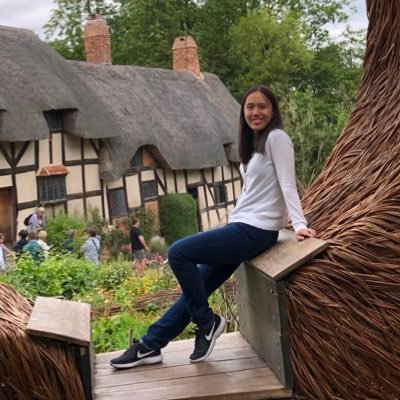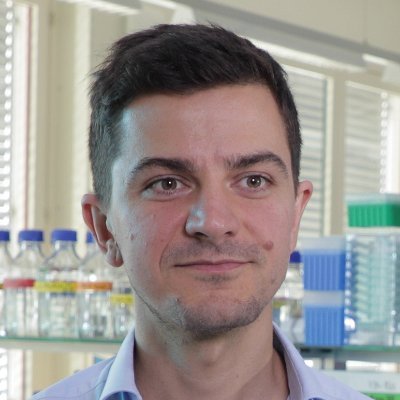
Karen Zhang
@thekarenzhang
Followers
125
Following
606
Media
5
Statuses
153
PhD candidate in Shipman Lab @GladstoneInst | @UCBerkeley - @UCSF BioE | Occasionally lost in fictional worlds
Joined January 2019
Been working on a really strange retron bacterial immune system, here's the preprint: https://t.co/iWP8qH1Fe7 Type VI retrons are unlike any other. Phage infection triggers reverse transcription of a DNA fragment that activates translation of a toxin to kill the infected cell.
2
41
134
It was great fun to have mentored an amazing summer intern, Kazuo Nakamura, through this project, and to work alongside wonderful scientists @matromont and @pentamorfico, with invaluable guidance from @seth_shipman.
0
0
0
Six new retrons just dropped! See how we isolated these cool bacterial immune systems from the wild in our latest preprint. From soil to sequence, we uncover the operons of these novel retrons and their phage defense properties. As a bonus, we repurpose them for genome editing 🧬
We just posted a new preprint where we found retrons in bacteria out in the real world, in dirt and water. We describe the first retrons in a handful of new species, show how they defend against phages, and use them to edit genomes. Read about it here: https://t.co/DiZmZOWCGs
1
3
6
*Preprint Alert* This one’s in a new area for the lab: phage editing! We're using retrons to produce recombineering donors ~inside~ bacterial hosts. A wild-type phage infects the host and an edited phage comes out.
biorxiv.org
Bacteriophages, which naturally shape bacterial communities, can be co-opted as a biological technology to help eliminate pathogenic bacteria from our bodies and food supply[1][1]. Phage genome...
12
59
190
We look towards a future of nanopore protein sequencing when single-molecule meets single-cell. scPeptide-barcoding, full-length protein reads, and “near-pore” processing…
A Comment by @KeisukeMotone and @jeffnivala highlights the challenges of fully decoding amino acids and their modifications using protein nanopore sequencing technology, and discusses its unique potential for single-cell proteomics. https://t.co/RnGrtPscSD
1
23
80
Check out our new review/opinion on molecular recording of transcriptional events by @sierra_lear. We write about where the field is, where it might be going, and what's stopping us from being there now.
1
17
64
Hear me out — my convo with @royanaieni is an all-time fav. Instead of trying to solve ONE specific disease, she’s making genetic engineering easier for everyone with robot arms! Pod: https://t.co/tcNJ6mnUXZ Apple: https://t.co/hSOaXtE7k3 Spotify:
open.spotify.com
The Most Important Question · Episode
Imagine the progress scientists could make if they didn't need to spend their limited time and resources on inefficient or tedious processes. This week, @776Foundation fellow @royanaieni discusses how her company, @trilobio is changing how synthetic biologists do science.
0
4
13
Proud to have worked with the wonderful @yuanjc08 and @jeffnivala, without whom this project would never have taken flight. Also many thanks to @seeliglab and the folks @datamolecules for their helpful advice and support!
0
1
8
The art of molecular computing expands further… Out now in @NatureComms: Synthetic DNA circuits can be directly detected, kinetically characterized, and multiplexed beyond fluorescence-based reporting capabilities - all on a @nanopore platform! https://t.co/egnvXCVkSo
2
19
102
"Voyage through Time" is my first artpiece using #stablediffusion and I am blown away with the possibilities... We're crossing a threshold where generative AI is no longer just about novel aesthetics, but evolving into an amazing tool to build powerful, human-centered narratives
235
3K
10K
I’m excited to introduce our Retro-Cascorder, out today in @Nature! This molecular device logs barcoded receipts of gene expression in a temporal genomic ledger. Sequence the ledger --> recover the history of gene expression.
nature.com
Nature - Retro-Cascorder, a system for time-ordered recording of transcriptional output, uses retrons as a tag to mediate DNA barcode acquisition in a CRISPR array.
28
376
2K
Online @nature is DNA Typewriter, a molecular recorder that allows for time-resolved recording of sequential events https://t.co/VabRxGxSrH
nature.com
Nature - A DNA memory device, DNA Typewriter, uses sequential prime editing to record the order of multiple cellular events.
0
96
434
In @ScienceMagazine we describe how a CRISPR-based bacterial recording system (Record-seq) captures signatures of diet, disease, and microbial interactions within the intestine – helping us understand how diet, disease, and the microbiota shape health. 1/12
15
218
878
Year end buzzer-beater preprint! We present a new readout method for DNA strand displacement reactions using @nanopore arrays: A nanopore interface for high bandwidth DNA computing
biorxiv.org
DNA has emerged as a powerful substrate for programming information processing machines at the nanoscale. Among the DNA computing primitives used today, DNA strand displacement (DSD) is arguably the...
1
18
51
Other highlights include: visualization of circuit kinetics by quantifying barcode capture frequency, and multiplexed detection of SNVs in miRNAs for disease diagnostics. Many thanks to @jeffnivala and @yuanjc08 for their unending supply of advice and wonderful ideas!
1
1
3
Introducing... parallel DNA computing on nanopores! Output strands from DNA circuits contain a barcode and biotin mod, enabling real-time readout by a nanopore sensor w/o sequencing. Dozens of unique barcodes can be detected in one rxn. Our new preprint: https://t.co/YBhudUnMEQ
1
21
64
Neural networks dream of electric Proteins 🐏🐑🐏🐑🐏🐑 now with experimental validation 🥳 https://t.co/LBBgC3BcvM
nature.com
Nature - The trRosetta neural network was used to iteratively optimise model proteins from random 100-amino-acid sequences, resulting in ‘hallucinated’ proteins, which when expressed in...
6
123
464










